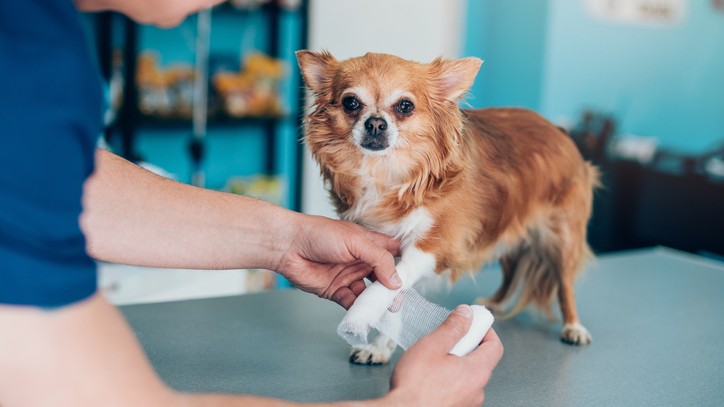Why is my dog limping? A vet answers...
If you see your dog limping, it can be worrying and upsetting, especially if they are in pain. But what causes your dog to limp?

Dogs can limp for lots of different reasons. Some are serious and require an urgent trip to the vet, whereas others are less concerning and might settle down with some rest and TLC.
For instance, if your dog is limping after a sudden and severe trauma, such as being hit by a car or falling from a height, it stands to reason that they will need an emergency appointment with the vet.
On the other hand, if they are limping after a recent walk that was considerably longer or more challenging than usual, they may just need a period of rest to recover. But how can you tell for sure whether your dog needs to see a vet for their limping?
Soft tissue injuries
A soft tissue injury is anything from a muscle strain to a stretched or torn ligament and with most soft tissue injuries, your dog is still able to put some weight on the leg, rather than holding it up off the ground and hopping.
Unless there is a full rupture of a ligament or tendon, most soft tissue injuries will respond well to a period of rest, sometimes combined with anti-inflammatory medication. The more severe the inflammation, the longer period of rest required for it to settle down.
For instance, if your dog is young, fit, and healthy, but over-exerts themselves on a long walk, they may feel some muscle soreness the next day, just as we would after a heavy session at the gym. This soreness is likely to improve after a couple of days of taking it easy.
On the other hand, if your dog falls on a walk and damages the cruciate ligament in their knee, they’ll need four or six weeks of strict rest at best, and may even need surgery to recover.
Get the best advice, tips and top tech for your beloved Pets
If your dog can put weight on their leg and it isn't too sore, you could try resting them initially. However, they may need some pain relief, so always speak to your vet if you are concerned. If your dog's limp hasn't improved after 48 hours of rest, it would be sensible to take them in for an examination.

Broken bones

There’s no NHS for pets. Veterinary care can be eye-wateringly expensive and most pets will need treatment for an illness or injury at some point in their life. It’s difficult to think about your animals being hurt or unwell, but you need to ask yourself: what would you do if you were faced with a vet bill for hundreds or thousands of pounds?
If your dog is limping because a bone is fractured or damaged, they are unlikely to put any weight on the leg. You may also see some swelling or unusual positioning.
Broken bones are normally painful and your dog is unlikely to tolerate you touching the leg, so be careful. Remember that some dogs are brave and won't show signs of pain, so even if they are not crying or whining that doesn't necessarily mean there isn't a serious injury.
If your dog is not weight-bearing on their leg, you must contact a vet straight away, especially if there is swelling or the leg looks abnormal. Your vet will need to examine your dog, give pain relief, and take an X-ray.
Other injuries
Some injuries are more obvious, as long as you take the time to look for them. Remember though, that if your dog is in pain, they could lash out, so be careful if you decide to do a bit of detective work to see if there is an obvious cause of the limp.
Firstly, check their nails for any that are overgrown or even ingrown. Then check for any signs of bleeding where one of the claws has been pulled away from the nail bed. Check between the toes for any signs of soreness or infection. You can also check the paw and pads for any small wounds, splinters or glass fragments, hair mats, or corns. All of these things can cause your dog to limp, and while some are quite easily solved, others will require the input of your vet.
When to take your dog to the vet for limping
It can be hard to know what to do if your dog starts limping out of the blue. On the one hand, you don't want an unnecessary vet visit, but you also don't want your dog to be in pain. It's also important to remember that some injuries can be made worse if treatment is delayed, especially if your canine pooch isn't taking it easy. So, it's important to recognize when your dog needs to see a vet so that you don't accidentally prolong their recovery time.
When a dog or puppy first injures their leg, they might hold it up for a few minutes due to the shock and sudden discomfort. However, if the injury is not serious, they should be able to put some weight on their leg after half an hour. After this time, if your dog is limping and not putting any weight at all on their leg, you must take them to a vet urgently. This is especially true if their leg is swollen or if there are any wounds.
If your dog's limp is mild, and you know that they have overdone it on a walk recently, you could try resting them for a couple of days. But if they don't improve, don't forget to contact your vet, as they might need some pain relief to keep them comfortable.
How to treat a limping dog at home
If your dog is not limping badly, or if a vet has already examined them, they will need nursing at home. While they are healing, it is essential that they rest. Therefore, for five to seven days, they should have no walks and only go out on a lead to go to the toilet. If your canine companion has free access to the garden, make sure that they are confined so that they can't run around outside. Because your pooch might struggle to move around, you should make sure that their food and water are close by, and extra padding on their bed will help them feel more comfortable.
It can be really difficult to keep your dog inside and reduce their exercise, especially in active dogs who usually enjoy a run-around or a long walk. However, it's important to remember that just because your dog seems to want a walk, this doesn't mean that they have recovered from their injury. Dogs often still choose to run or play even though they are in pain. By keeping them rested, you ensure a recovery that is as smooth as possible so that your furry exercise buddy will be back by your side in no time!
Dr Hannah Godfrey is a small animal vet who graduated from the Royal Veterinary College in 2011 and began work straight away at a busy mixed practice. Initially, she treated all species, but focussed on small animals from 2014. She has a passion for soft tissue surgery, ultrasound, and canine and feline dentistry, having completed additional training in these areas.

